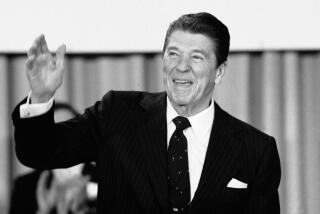Repair Leads Post-Volcker Agenda
- Share via
Let’s begin with the obvious. Any central banker knows how to overcome inflation.
Since 1945, central bankers in Western Europe, Latin America and elsewhere have repeatedly, if temporarily, halted and reversed price escalation. All that the central banker needs to do is slow the printing presses, push interest rates up, discourage business and consumer borrowing--and precipitate a recession. Sound editorialists will celebrate his courage and confide to their readers that the medicine, though painful, will in due course restore the bloom to the cheeks of the economy.
The art of central banking, in other words, is the infliction of financial damage on laid-off workers, overextended farmers, smallbusinesses and the communities that depend on them. The praiseheaped on the head of departing Federal Reserve Board Chairman Paul A. Volcker attests to his capacity to endure stoically the misfortunes of his fellow citizens.
He warmed up in 1980, when his slowing of monetary growth and acquiescence in consumer credit controls caused a brief recession that helped Ronald Reagan replace Jimmy Carter. But the main event was the mini-depression of 1981 and 1982. There is excellent reason to believe that gentler restraint on credit creation, coupled with OPEC’s disarray, could have brought inflation down with much less unemployment and lost output.
In December, 1982, unemployment peaked at 10.7%, the highest figure in three decades. Only in the last three months has the rate of joblessness fallen below 7%. Because of high joblessness during the Reagan years, many hundreds of billions of dollars of potential output have been unnecessarily lost. Never enjoyable, unemployment has become more painful for idled workers as a result of major cuts in welfare, food stamps, Medicaid and other social programs.
Worse still, the very intensity of the 1981-1982 contraction has altered public expectations. In the 1960s and 1970s, 6% or 7% unemployment indicated recession and alarmed presidents and congresses. President Nixon imposed wage and price controls and pumped up government spending in reaction to 5% unemployment.
The employed public, encouraged by economists who mutter about “natural” rates of unemployment, currently appears to accept a 6% or 7% jobless rate as tantamount to full employment, or at least consistent with low inflation.
Volcker’s policies contributed to the overvaluation of the dollar and the belated efforts of the past two years to talk the dollar down to some reasonable relationship with the Japanese yen and the German mark. That overvaluation, in turn, increased Japanese and German exports to the American market and our international trade deficit.
Unfavorable exchange rates stimulated the export of American jobs, inflicted heavy damage on manufacturing and substantially weakened trade unions. Even with a deflated dollar, American producers will encounter great difficulty in regaining the markets lost earlier in this decade.
Volcker was a discreetly silent partner in the anti-union policies of the Reagan Administration. The Fed’s high-interest-rate policy has been responsible for sluggish investment, a loose labor market and the resultant ability of employers to replace easily workers they have locked out.
Last year, employers locked out 55,000 workers and promptly replaced them with cheaper substitutes.
Under Volcker, the Fed countenanced a blatant bank scam. Banks were allowed to list loans to Third World debtors as assets--loans as likely to be repaid by those countries as the Soviet Union is to redeem Imperial Russian bonds. With Federal Reserve encouragement, banks lent new money to Mexico, Brazil, Argentina and smaller borrowers so that they could pay interest on old loans. John S. Reed, chairman and chief executive of Citicorp, introduced a note of realism recently when he dramatically enlarged bad debt reserves and tacitly conceded that a substantial portion of Citicorp’s Latin American portfolio was at risk.
In sum, Volcker has been true to the tradition of central banking: protection of the strong and sacrifice of the weak. Major banks, like Continental Illinois, cannot be allowed to declare bankruptcy lest financial markets panic. Wall Street greets calmly news of layoffs, small-business bankruptcies, plant closings and farm foreclosures.
In the topsy-turvy universe of high finance, low unemployment is bad news. The Fed might take it as a sign of renewed inflationary pressure and a sufficient reason to push interest rates higher. When lesser Volckers in countries like Egypt, under pressure from the International Monetary Fund, impose austerity on ordinary citizens, riots have more than once ensued. In conservative America, the natives are quiet.
Volcker’s legacy is a more powerful corporate sector, a far weaker labor movement and unaddressed Third World debt problems. The wonder is not that he remains popular in respectable financial circles; it is that he is less unpopular than he deserves to be among the vulnerable groups he has injured.
His fixation on inflation, to the practical exclusion of any interest in rapid growth and high employment, has skewed the economic agenda in a highly undesirable direction. One can only hope that his successor, Alan Greenspan, who bills himself as a shorter Volcker, will rearrange the departing hero’s priorities.
More to Read
Inside the business of entertainment
The Wide Shot brings you news, analysis and insights on everything from streaming wars to production — and what it all means for the future.
You may occasionally receive promotional content from the Los Angeles Times.









